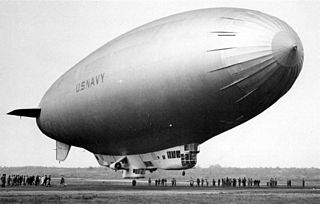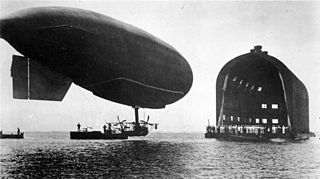
The Goodyear Blimp is any one of a fleet of airships operated by the Goodyear Tire and Rubber Company, used mainly for advertising purposes and capturing aerial views of live sporting events for television. The term blimp itself is defined as a non-rigid airship—without any internal structure, the pressure of lifting gas within the airship envelope maintains the vessel's shape.

The K-class blimp was a class of blimps built by the Goodyear Aircraft Company of Akron, Ohio for the United States Navy. These blimps were powered by two Pratt & Whitney Wasp nine-cylinder radial air-cooled engines, each mounted on twin-strut outriggers, one per side of the control car that hung under the envelope. Before and during World War II, 134 K-class blimps were built and configured for patrol and anti-submarine warfare operations, and were extensively used in the Navy’s anti-submarine efforts in the Atlantic and Pacific Ocean areas.

The G-Class Blimps were a series of non-rigid airships (blimps) used by the United States Navy. In 1935, instead of developing a new design airship, the Navy purchased the Goodyear Blimp Defender for use as a trainer and utility airship assigning it the designator G-1. Defender was built by the Goodyear Aircraft Company of Akron, Ohio and was the largest blimp in the company’s fleet of airships that were used for advertising and as passenger airships. Goodyear built additional G-class airships for the Navy during World War II to support training needs.

The L-class blimps were training airships operated by the United States Navy during World War II. In the mid-1930s, the Goodyear Aircraft Company built a family of small non-rigid airships that the company used for advertising the Goodyear name. In 1937 the United States Navy awarded a contract for two different airships, K-class blimp designated K-2 and a smaller blimp based upon Goodyear's smaller commercial model airship used for advertising and passenger carrying. The smaller blimp was designated by the Navy as L-1. It was delivered in April 1938 and operated from the Navy's lighter-than-air facility at Lakehurst, New Jersey. In the meantime, the Navy ordered two more L-Class blimps, the L-2 and L-3, on September 25, 1940. These were delivered in 1941. L-2 was lost in a nighttime mid-air collision with the G-1 on June 8, 1942.

The J-class blimps were non-rigid airships designed by the Navy Bureau of Aeronautics and Goodyear Tire & Rubber Company in the early 1920s for the US Navy.

The Goodyear Aircraft Company of Akron, Ohio built the M-class blimp for the US Navy as the follow-on to the K-class anti-submarine warfare blimp used during World War II. It was a significantly larger airship, 50% larger than its predecessor. Four airships, designated M-1 through M-4, were delivered in early 1944. Operations of K-ships in tropical regions had shown a need for a blimp with greater volume to offset the loss of lift due to high ambient temperatures.

The SSZ non-rigid airships or "blimps" were developed in United Kingdom during World War I from the earlier SS class. The main role of these craft was to escort convoys and scout or search for German U-boats. A secondary purpose was to detect and destroy mines.

Beginning in 1908 and ending in 1937, the U.S. Army established a program to operate airships. With the exceptions of the Italian-built Roma and the Goodyear RS-1, which were both semi-rigid, all Army airships were non-rigid blimps. These airships were used primarily for search and patrol operations in support of coastal fortifications and border patrol. During the 1920s, the Army operated many more blimps than the U.S. Navy. Blimps were selected by the Army because they were not seen as "threats" on the battlefield by opposing forces, unlike airplanes, due to their passive role in combat.

The DN-1 was the United States Navy's first airship.

The B class blimps were patrol airships operated by the United States Navy during and shortly after World War I. The Navy had learned a great deal from the DN-1 fiasco. The result was the very successful B-type airships. Dr. Jerome Hunsaker was asked to develop a theory of airship design, Lt. John H. Towers had returned from Europe having inspected British designs, and using reports from attachés on British airship operations, the Navy was prepared to seek bids for blimps from American manufacturers. On 4 February 1917 the Secretary of the Navy directed that 16 nonrigid airships of Class B be procured. A February 12, 1917 meeting with the Chief of the Bureau of Construction and Repair, and representatives of Goodyear, Goodrich, Connecticut Aircraft Company, Curtiss Aeroplane and Motor Corporation, and U.S. Rubber Company, it was agreed that the order for 16 dirigibles was beyond the capability of any one company. The conference resulted in a committee to coordinate on sharing raw materials, information and experience. Ultimately Goodyear manufactured 9 envelopes, Goodrich made 5 and Curtiss assembled the gondolas for all of those 14 ships. Connecticut Aircraft contracted with U.S. Rubber for its two envelopes and with Pigeon Fraser for its gondolas. The Curtiss-built gondolas used by Goodyear and Goodrich used modified Curtiss JN-4 fuselages powered by Curtiss OXX engines. The Connecticut Aircraft blimps were powered by Hall-Scott engines. One ship, B-20 was equipped with a special control car. All B-Class airships were delivered to the Navy between August 1917 (B-1) and September 1918 (B-20).

The C-class blimp was a patrol airship developed by the US Navy near the end of World War I, a systematic improvement upon the B-type which was suitable for training, but of limited value for patrol work. Larger than the B-class, the C-class blimps had two motors and a longer endurance. As with the B-class, the envelope production was split between Goodyear and Goodrich, with control cars being built by the Burgess division of Curtiss Aeroplane and Motor Company. Originally the Navy ordered 30 but reduced the number to 10 after the armistice in November 1918. All ten of the "C" type airships were delivered in late 1918, and examples served at all of the Navy's airship stations from 1918 to 1922. In 1921, the C-7 was the first airship ever to be inflated with helium. The Navy decommissioned its last two remaining C-type blimps, the C-7 and C-9 in 1922.

The E class of US Navy blimps comprised a single airship, built during World War I by Goodyear as one of a group of three small blimps offered to the US government. Two were purchased for the US Navy and one for the US Army. The Navy blimps were designated E-1, F-1, and the Army airship A-1. These airships had identical envelopes but different cars. The E-1 was delivered to Pensacola, Florida in December 1918. It was flown only at Pensacola serving as a trainer at the Airship School. A new envelope was provided in December 1920. E-1 was retired from service sometime in 1924.

The F class of US Navy blimps comprised a single airship, built during World War I by Goodyear as one of a group of three small blimps offered to the US government. Two were purchased for the US Navy and one for the US Army. The Navy blimps were designated E-1, F-1, and the Army airship A-1. Classified as an "Experimental Engine Testing Dirigible." F-1 had the same envelope size as the E-1, due to the use of a tractor mounted 125 hp Union engine, the performance was different. F-1 spent its entire career at Hampton Roads. It was flown in both tractor and pusher configurations. It also may have been flown with a Curtiss OXX engine. F-1 was removed from inventory in November 1923.

The H class blimp was an observation airship built for the U.S. Navy in the early 1920s. The original "H" Class design of 1919 was for a twin engined airship of approximately 80,000 cubic feet volume. Commander Lewis Maxfield suggested that a small airship which could be used either as a tethered kite balloon, or be towed by a ship until releasing its cable, would be able to scout on its own. The concept was an airship similar to the later Army Motorized Kite Balloons.
The K-1 was an experimental blimp designed by the United States Navy in 1929. The K-1 was not the prototype of the later K-class blimps.

During the First World War, the United States Navy trained crews at British bases, and operated British designed and built blimps on combat patrols. The Navy purchased three types of British blimps. Operations were flown in a US SSZ and airships operated by the Royal Navy.
Records concerning the history of French airships in US Navy service are fragmentary. A number of airships of various classes were operated by the US Navy (USN) during World War I from the French Naval Base at Paimbœuf, which was designated a US Navy Air Station from 1 March 1918 onward. It appears that at least 13 French manufactured airships were operated by the USN from Paimbœuf; six were eventually shipped to the United States and one was returned to France before the armistice. The Navy operated or ordered four Astra-Torres type airships, one T-2—the Captain Caussin, two CM types, and three or four VZ types.

The Goodyear GZ-20/20A was a class of non-rigid airship or blimp introduced in 1969 by The Goodyear Tire and Rubber Company in the United States as its signature promotional aircraft, the Goodyear Blimp. The design is based on the previous Goodyear GZ-19 class. The GZ-20 featured a larger envelope to carry the "Super-Skytacular" advertising night sign and more powerful engines. The GZ-20s were the mainstay of Goodyear's airship operations until 2017, when they were replaced with the new Zeppelin NT semi-rigid airship.
The SST class of non-rigid airship or "blimp" was developed in Great Britain during World War I from the earlier SS class airship. The main role of these craft was to escort convoys and scout or search for German U-boats. A secondary purpose was to detect and destroy mines.
















